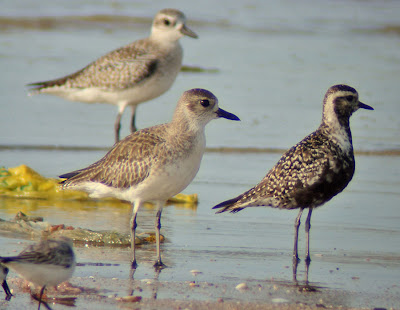American Golden-Plover in Veracruz

As promised yesterday, a group of fearless birders (Rosabel Miró, Gloriela Archbold, Jan Axel Cubilla, Venicio Wilson and Darién Montañez) headed to Veracruz this morning to hunt for the Hudsonian Godwit seen yesterday. At press time the godwit had not been relocated, but the morning did produce an American Golden-Plover in a small flock of Black-bellied Plovers. Unlike every other bird in the group, this plover had a lot of black in the chest, and we're calling it an adult molting to alternate plumage (or from it; more on that later. We have digiscoped photos coming in from Rosabel and Jan Axel, plus real photos from Jan Axel, that may allow us to better age it). Besides the striking difference in plumage, this plover was noticeably smaller, and had a shorter, thinner bill that looked more conical than the more cylindrical Black-bellied Plover bills. Its head also looked smaller and rounder, with the forehead meeting the bill almost vertically. Its stance was more vertical, too, and it looked slimmer than the surrounding plovers.
The neck, chest and belly of the golden-plover were mostly black with a few light feathers throughout, especially on the undertail coverts. The sides of the neck, supercilium and forehead were still white, and the two white patches on the sides of the chest were very evident. These did not seem to extend down into the flanks. The upperparts were mottled light and dark, and their hue did not seem dramatically different from those on the nearby juvenile Black-bellieds.
The bird was first seen at around 7:30 am from the parking lot at the first beach-front restaurant, and we spent the rest of the morning inching closer and (after it flew off into the other end of the beach, well past the last restaurant) watching it on some offshore rocks. It finally flew back into the beach, which allowed for better photos to be taken, and for us to notice the very long primaries projecting well beyond the tip of the tail, which clinched our id.
It is totally unexpected to find a golden-plover in this plumage in January, as it is way too late for a prebasic molt (which should be complete by October) and too early for a prealternate molt (which occurs between February and early May. It's also weird (although not unheard of) to find a golden-plover in Panama in January, so we either got really lucky or totally misidentified it. Any insights are, as always, welcome via the comments.
